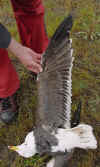sub-adult (4+ cy): January - April
Last update of this page: 26-07-05 16:16
Sub-adult LBBG in 4cy and 5cy very much resemble birds in adult plumage. On average, 4cy birds may still show a few immature features, but on the other hand some 4cy match the average adult very well and may be difficult to identify.
Only
very few sub-adults remain in the Netherlands during the first three
months of the year. Together with adults, sub-adults return to the
colonies in spring and maybe a few will already breed. It's difficult to separate sub-adults from adults,
although sub-adults normally show:
- some black on the bill
- pale yellow
legs
- or no pure yellow irises.
However, this may occur in adults in winter plumage as
well.
Best features to distinguish sub-adults from adults are:
- less developed primary tips,
- less developed primary mirrors (but beware of smaller sized mirrors in females, normally only showing a P10 mirror),
- extensive black on the bill,
- extensive wear in the coverts with a brown hue, already early in spring and sometimes a hint of barring.
  |
Car
acccident sub-adult LBBG in the colony.
Died today. Check this web page to get an idea of grey-tone, bare parts coloration and pattern on tail, secondaries and primaries. Bottom image: a fresh 4cy LBBG, with black in the tail and on all secondaries. |
 |
 LBBG 5cy
EU93,
April 16 2001, ECT centrale Maasvlakte, the Netherlands.
Ringed in June 1997, EU93 was recorded on October 23rd 1997
along the coast of Portugal.
LBBG 5cy
EU93,
April 16 2001, ECT centrale Maasvlakte, the Netherlands.
Ringed in June 1997, EU93 was recorded on October 23rd 1997
along the coast of Portugal.
 LBBG
or michahellis x argenteus 4cy EV65 ,
April 02 2000, Neeltje Jans, the Netherlands. Photo by Pim Wolf. A sub-adult winter LBBG with a Dutch
ring: EV65, born at Maasvlakte, the Netherlands in summer 1997.
LBBG
or michahellis x argenteus 4cy EV65 ,
April 02 2000, Neeltje Jans, the Netherlands. Photo by Pim Wolf. A sub-adult winter LBBG with a Dutch
ring: EV65, born at Maasvlakte, the Netherlands in summer 1997.
 LBBG BLB L-93303
4cy,
April 06 2003, Dintelhaven - Maasvlakte, the Netherlands (51.59N,04.02E).
LBBG BLB L-93303
4cy,
April 06 2003, Dintelhaven - Maasvlakte, the Netherlands (51.59N,04.02E).
 Photo
4: LBBG sub-adult, Nachtegalenkeet Maasvlakte, the Netherlands, April 12 2001. Probably a
4cy male moulting to 3rd summer plumage.
Photo
4: LBBG sub-adult, Nachtegalenkeet Maasvlakte, the Netherlands, April 12 2001. Probably a
4cy male moulting to 3rd summer plumage. Photo
5: LBBG (sub)adult,
April 16 2001, Nachtegalenkeet Maasvlakte, the Netherlands.
A rather dark LBBG, resembling intermedius
from Scandinavia.
Photo
5: LBBG (sub)adult,
April 16 2001, Nachtegalenkeet Maasvlakte, the Netherlands.
A rather dark LBBG, resembling intermedius
from Scandinavia.  Photo
11: LBBG 5cy,
April 16 2001, Nachtegalenkeet, Maasvlakte, the Netherlands.
Photo
11: LBBG 5cy,
April 16 2001, Nachtegalenkeet, Maasvlakte, the Netherlands. Photo
12: LBBG 4cy ...22 ,
April 30 2003, Boulogne-sur-Mer, NW France. Probably ringed in Sweden.
Photo
12: LBBG 4cy ...22 ,
April 30 2003, Boulogne-sur-Mer, NW France. Probably ringed in Sweden.